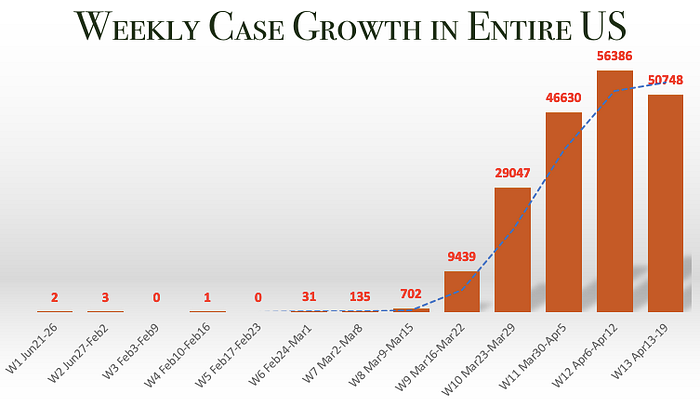最後更新時間 02/22/2022
New confirmed cases have been showing positive signs temporarily. The fact is the situation is not stable and cannot be predicted. I did simple research about confirmed COVID-19 cases. The data is according to The New York Times. The timeframe is from Jan.21, when the first case happened in Washington state, to Apr. 19.

The graphs I created track weekly and daily total case growth in the entire US. Let’s see the peak week first. It was Week 12, from Apr.6 to Apr.12, when the number of new cases was 56,386. Last week (Apr.13 — Apr.19) the new case total was 50,748, which indicates a decrease of 5,638. This number seems to suggest that new cases are slowly decreasing. However, at first, it was the first time it started to decrease. A few weeks later, we still have no idea whether the apparent decrease is permanent.

Also, when we see the daily graph, it actually shows us an unstable situation. For example, the number of new cases decreased greatly to 25,235 on Apr.5 from the previous day’s 35,035, but then increased gradually from April 6 through Apr.9. Then, by April 10, it was decreasing again, only to increase again. The numbers have continued to fluctuate. We cannot definitively say it is a slowdown.

Please note that the number for New York, unlike the other states listed, should be read on the right-hand side. NY’s confirmed case count is an order of magnitude higher than any other state.
These two graphs I complied weekly and daily case growth for each of my seven key states. In the same situation, from weekly graph, it showed the new confirmed cases decreased. However, turning to the magnified graph, we can observe the line fluctuates almost every day. New York confirmed 12,126 on Apr.4 new cases and after 11 days confirmed 11,571 new cases, which was a new peak.
Did you notice that the Florida government just announced to reopen beaches from last Friday, Apr.17? We can see the number of new cases increased dramatically to 1,413, the biggest number to date, on Apr.17. Florida is not alone in having a large confirmed new case count. During the same week, on Apr.19, California confirmed 1,431, the second-highest total in the state to date.
The states represented in the graph were chosen for a mix of statistical and personal reasons. Statistically, Washington is the site of the first reported case, while California and New York are big states with many cases. Illinois has a big city, Chicago, too, but I chose it because my good friend lives there, which is the same rational for choosing the fifth and sixth state, North Carolina and Florida. Finally, I selected Texas, which is not only yet another large state, but also my current place of residence.

I don’t think we are ready for reopening the economy, even though my motivation when I began to write this article was positive: I had to say we could go out soon. However, after finishing the research for this article, I would say we are not ready, and we should stay home and keep taking care of ourselves.


